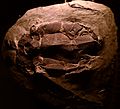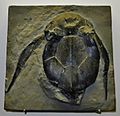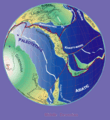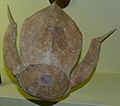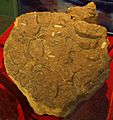Bothriolepis facts for kids
Quick facts for kids BothriolepisTemporal range: Late Devonian
387–360 mya |
|
|---|---|
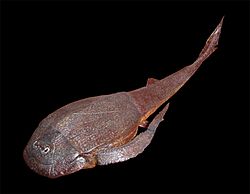 |
|
| Model of B. canadensis | |
| Scientific classification | |
| Kingdom: | |
| Phylum: | |
| Subphylum: | |
| Class: | |
| Order: | |
| Family: |
Bothriolepididae
|
| Genus: |
Bothriolepis
|
Bothriolepis was a type of ancient armored fish that lived a very long time ago. These fish were part of a group called placoderms, which means "plate-skinned" because they had bony armor. Bothriolepis was especially common and diverse during the middle to late Devonian Period, which was about 387 to 360 million years ago.
These fascinating fish lived all over the world, in many different environments. You could find them in places near the ocean coast, as well as in freshwater rivers and lakes. Most species of Bothriolepis were quite small. They usually stayed near the bottom of the water, eating decaying plant and animal material. This means they were like the clean-up crew of their ancient habitats!
Contents
Meet Bothriolepis: An Ancient Armored Fish
Bothriolepis was a genus of antiarch placoderms. This means they were a specific kind of armored fish with unique features. They had a special body shape with a head and front part covered in bony plates. This armor helped protect them from predators in the ancient seas and rivers.
What Did Bothriolepis Look Like?
Most Bothriolepis species were about 30 centimetres (12 in) (about 1 foot) long. Imagine a fish about the size of a ruler! However, some species were much bigger. The largest known species, called B. maxima, could have a carapace (its armored body section) up to 100 centimetres (39 in) (about 3 feet) long. That's as long as a small child!
Where Did Bothriolepis Live?
Fossils of Bothriolepis have been found on every continent. This shows that they were very successful and lived in many different places around the world. They preferred environments where they could find plenty of food at the bottom of the water. This wide distribution is similar to how many modern bottom-dwelling animals live today. Over 70 different species of Bothriolepis have been discovered by scientists.
Images for kids
-
B. canadensis fossil in the Field Museum of Natural History, Chicago
-
B. canadensis preserved with Scaumenacia cyrta, a prehistoric sarcopterygian
See also
 In Spanish: Bothriolepis para niños
In Spanish: Bothriolepis para niños


